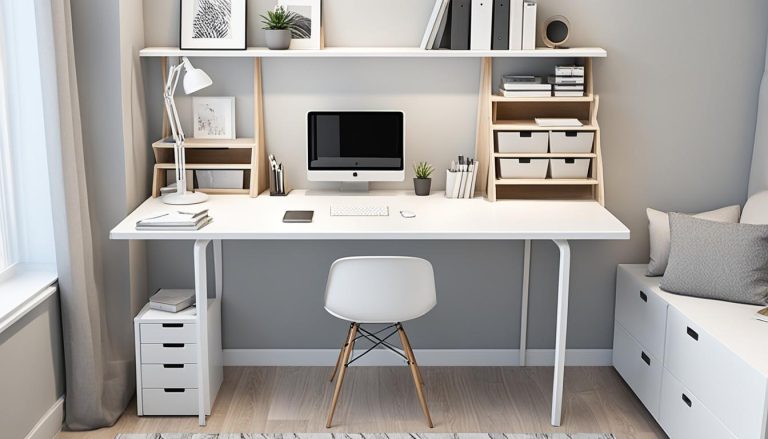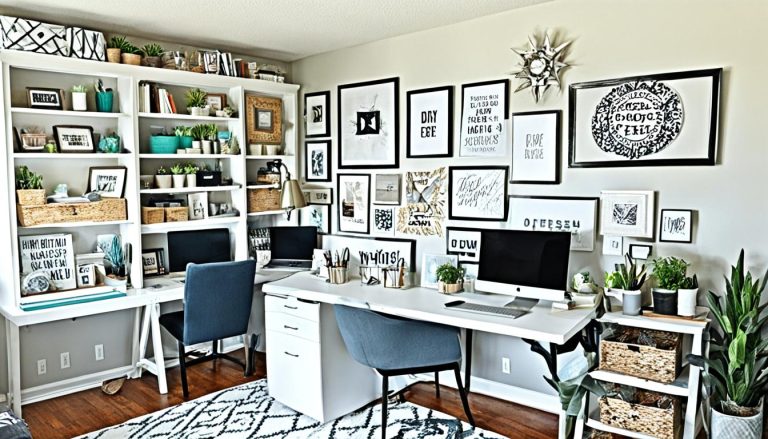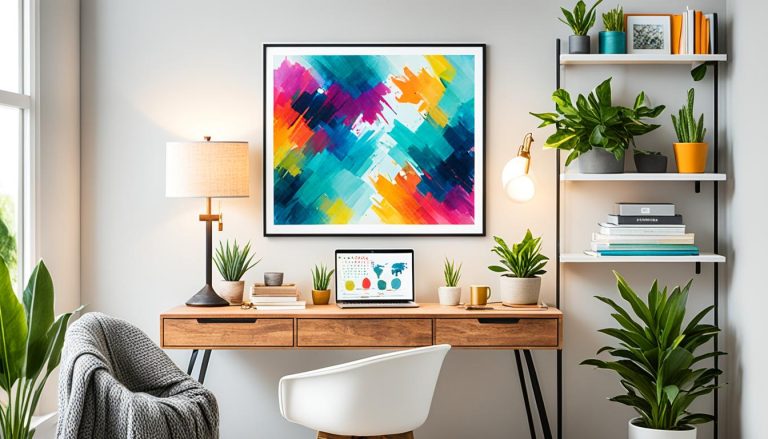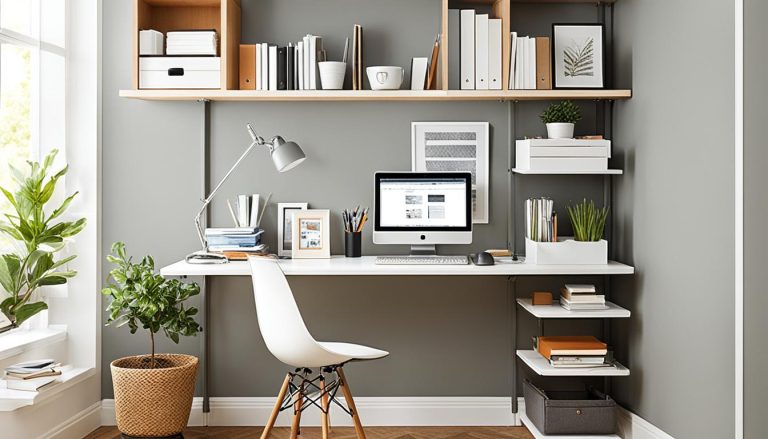Creating a Dual-Purpose Home Office: Maximize Space and Productivity
houseremodelingnews.com may earn a commission if you purchase a product through one of our links
Imagine sipping your morning coffee while looking out your window. The world is busy, but you’re starting your workday at home. This is true for many, as 40% of Americans work from home full-time and 35% choose a mix of home and office work. Our work lives are changing, and so should our living spaces.
The dual-purpose home office is a big change for those of us working from home more. It’s not just a trend; it’s essential for making the most of our living space. Whether your home is big or small, having a flexible office design is crucial for success in today’s work world.
This guide will show you how to turn your space into a work-life hybrid. We’ll cover smart storage and furniture choices for a dual-purpose home office. This space will not only increase your productivity but also improve your well-being. Are you ready to change your work-from-home setup? Let’s start!
Understanding the Need for a Dual-Purpose Home Office
Remote work has changed how we see our homes. More people want to work from home. This has made dual-purpose home offices popular. It shows how we need smart ways to use our space.
The Rise of Remote Work and Flexible Living Spaces
More companies are letting employees work from home. This has changed how we design our living spaces. Now, we’re creating areas that work for both work and leisure.
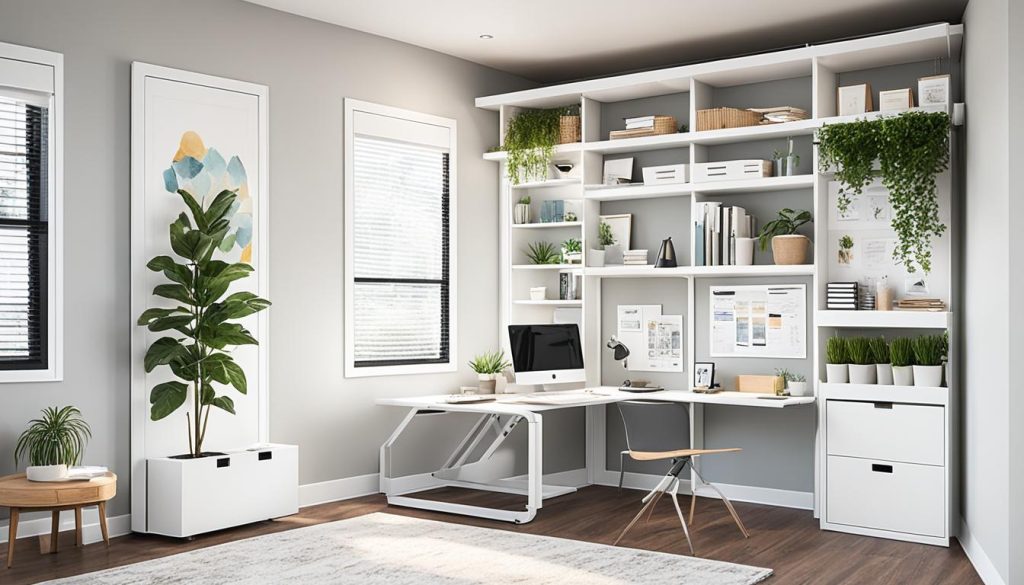
Balancing Professional and Personal Life in One Area
Having a dual-purpose home office means more than just a spot for your laptop. It’s about blending work and life smoothly. By designing spaces that easily switch from work to play, you keep your life balanced.
Maximizing Space Efficiency in Smaller Homes
If you live in a small home or apartment, space is precious. Dual-purpose home offices are a great way to save space. With smart furniture and storage, you can make a workspace that doesn’t take over your living area.
- Use wall-mounted desks that fold away when not in use
- Opt for furniture with hidden storage compartments
- Consider vertical storage solutions to maximize floor space
Adopting these trends not only meets the needs of remote work but also makes your home more functional. With some planning, your dual-purpose home office can be both productive and cozy.
Assessing Your Space and Needs
Creating a work-from-home setup needs careful planning. Start by looking at your living space with fresh eyes. You might find spots perfect for a flexible office layout.
Identifying Available Areas
Walk through your home. Look for unused corners, nooks, or even closets. These can be turned into compact workspaces. Remember, a space-saving office design doesn’t need much room to be effective.
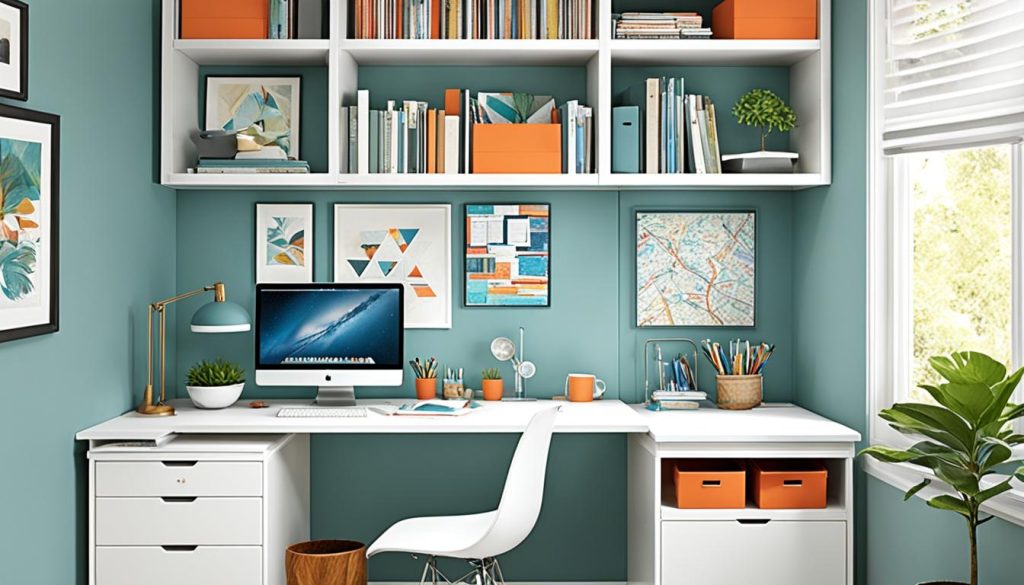
Determining Functions
Think about what you need from your office. Will it be just for work, or does it need to serve other purposes? A dining area that doubles as a workspace can be a smart solution. List your must-haves to guide your planning.
Your Work Style Matters
Consider how you work best. Do you need quiet? Prefer standing sometimes? Your habits should shape your office design. A flexible office layout can adapt to your changing needs throughout the day.
- Measure your available space carefully
- Plan for at least 120 square feet of work area
- Budget for about $38 per square foot on average
- Think about storage solutions to keep your space tidy
Remember, your home office should fit your life. With thoughtful planning, you can create a space that boosts productivity and fits seamlessly into your home.
Designing a Dual-Purpose Home Office
Creating a hybrid office at home needs careful planning and creative ideas. With 42% of Americans working from home part-time, versatile spaces are essential. Your aim is to make a space that helps you work well and also fits your personal life.
First, look at the space you have. Did you know 68% of homes have unused guest rooms? These rooms are great for turning into offices. If you don’t have much space, think about turning a closet into a small office. 31% of homeowners are doing this to use their space better.

Being flexible is important when designing your office. Choose furniture that can be used for different things. For example, rolling desks and chairs make it easy to change the setup. Sleeper sofas are also popular because they offer comfort for both work and rest. The need for these versatile items has gone up by 25% in the last few years.
- Use area rugs to define separate zones within the room
- Invest in foldable or nesting tables for adaptable workspace
- Choose a Murphy bed or daybed for guest accommodations
Good lighting is key for a productive office. Use natural light if you can, and add task lights for focused work. A well-designed dual-purpose office can make you more productive and improve your living space. It’s a smart choice for your home and career.
Flexible Furniture Solutions
Optimizing your home office means making smart furniture choices. With more people working from home, having adaptable office space is key. Let’s look at ways to make your workspace both functional and comfortable.
Multi-functional Pieces for Versatility
For small spaces, compact office solutions are vital. Here are some versatile options:
- Sleeper sofas that transform from seating to sleeping areas
- Rolling desks that can be moved as needed
- Modular furniture systems adaptable to different layouts
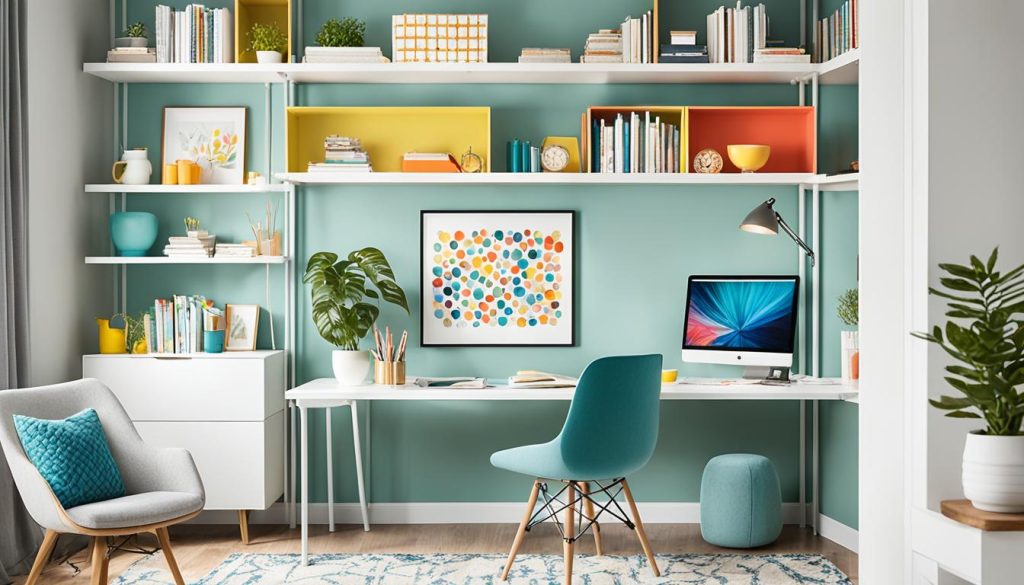
Ergonomic Choices for Comfort and Productivity
Ergonomic furniture is crucial for long hours at your desk. Sit-stand desks help with focus and blood flow. Choose adjustable chairs and monitor stands to keep your posture right all day.
Space-saving Options for Compact Areas
For small spaces, try these smart ideas:
- Murphy beds with built-in desks for guest room offices
- Wall-mounted folding desks that disappear when not in use
- Nesting tables for flexible work surfaces
Over 40% of people now use their living room as a home office. By picking furniture that serves more than one purpose, you can have a productive space without losing your home’s charm.
Clever Storage Ideas for Work and Personal Items
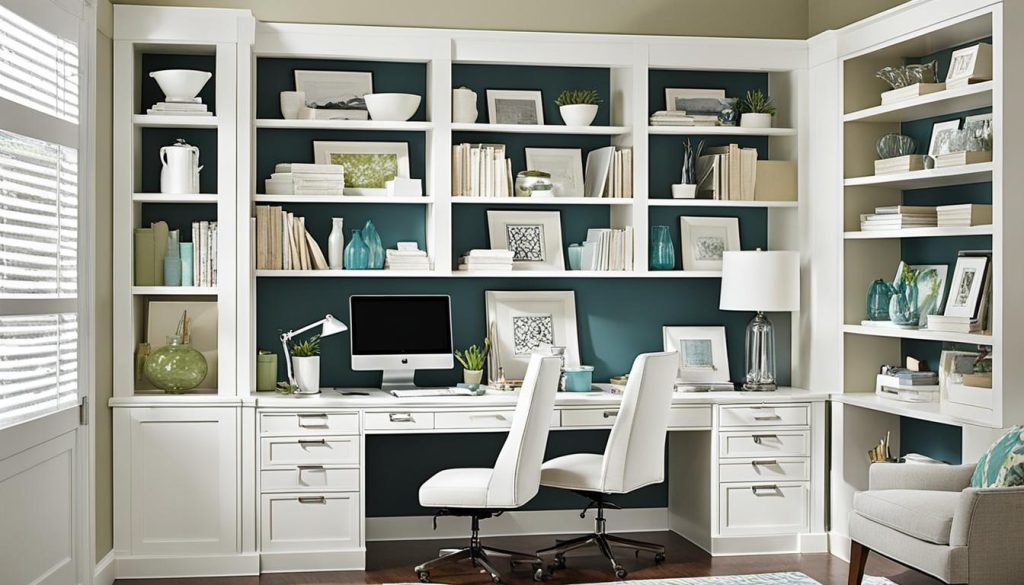
In today’s world, smart storage is crucial for hybrid living areas. It helps keep work and personal items organized. You can use every inch of your space without losing style or functionality.
Built-in bookcases are a popular choice, saving up to 50% of space. They offer plenty of storage and make your home office look great. For those with little floor space, wall-mounted folding desks are a big help. About 35% of small home office users pick these to save space.
Vertical shelving units are great for small spaces. Nearly 65% of people with compact workspaces use them to stay organized. Adding ottomans or benches with hidden storage is also smart. 30% of home office owners choose this for extra storage.
- Use floating shelves for a sleek, modern look
- Install pegboard walls to organize accessories
- Opt for rolling file cabinets for mobile storage
- Utilize over-the-door organizers for papers and files
Thinking creatively is key to great storage in flexible home layouts. By using these smart ideas, you’ll make your hybrid living area both beautiful and functional.
Incorporating Technology Seamlessly
In today’s world, technology is key to making workspaces efficient. By adding tech to your home office, you can work better and enjoy your work more.
Cable Management Solutions
Keep wires in check with smart cable management. Use cord clips, cable sleeves, or under-desk trays to hide cables. This makes your space look better and keeps you safe from tripping.
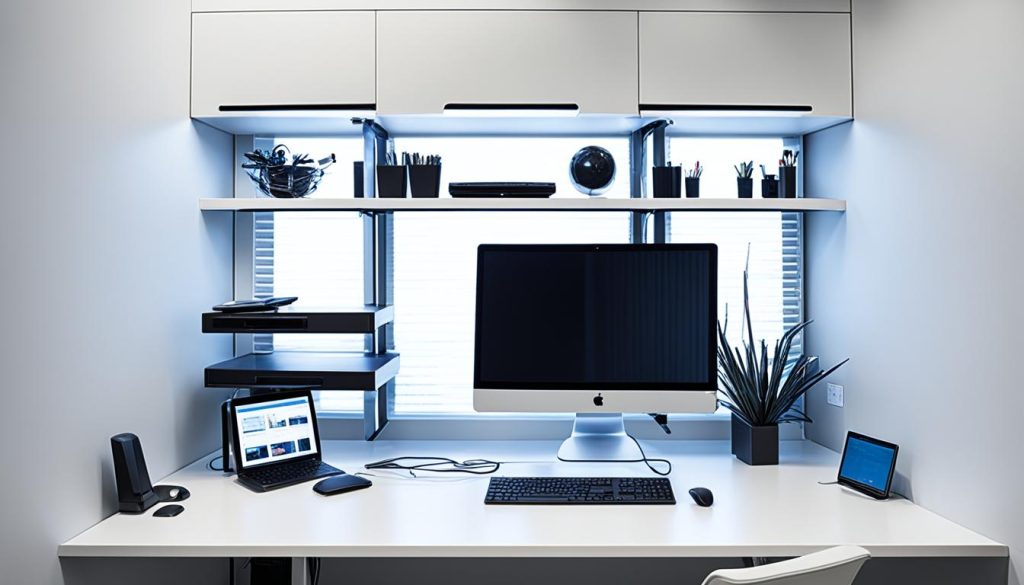
Integrating Smart Home Devices
Upgrade your furniture with smart tech. Voice-activated helpers manage your schedule and reminders. Smart plugs save energy by turning devices off when not in use.
Choosing the Right Tech Accessories
Pick tech accessories that fit your home office. Wireless keyboards and mice cut down on clutter. Noise-canceling headphones help you focus. Studies show a dual-monitor setup can boost productivity by 25%.
- Invest in a high-quality webcam for virtual meetings
- Consider a portable power bank for flexibility
- Use a docking station to connect multiple devices easily
By adding technology wisely to your home office, you make a space that meets your needs. It helps balance your work and personal life. Aim for a smooth mix of looks and usefulness in your workstation.
Creating Distinct Zones Within Your Space
Making separate areas in your home office boosts productivity. By dividing your space, you keep focused and separate work from rest. This is very important in small offices where every inch matters.
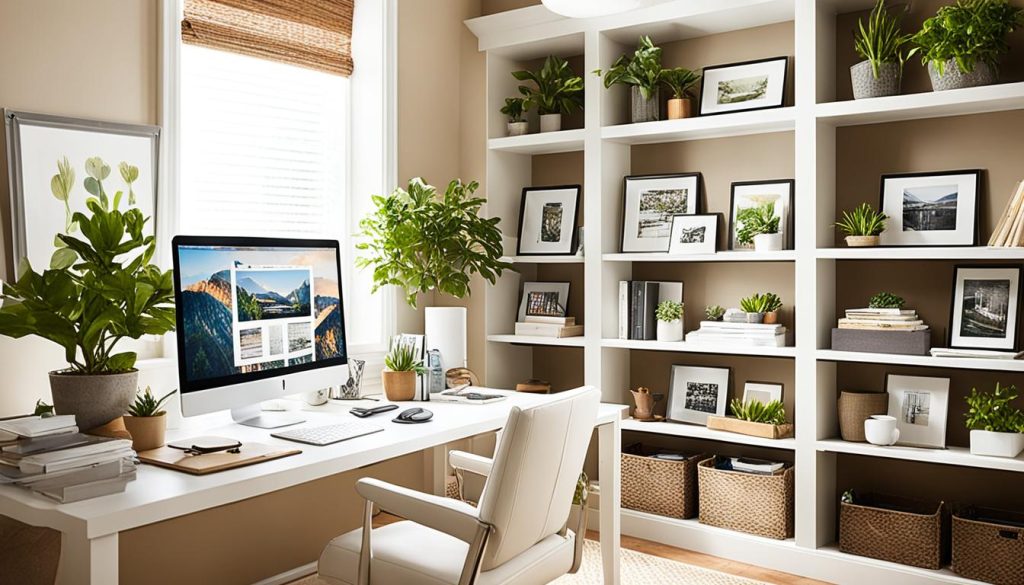
Begin by using area rugs to mark different areas. A rug under your desk shows where work happens, and another near a reading spot makes it a place to relax. This easy trick can make your office feel bigger by 48% and set clear boundaries.
Where you put your furniture is key to making zones. Place your desk so it’s away from distractions. Use a bookshelf or screen to divide the room. This can make your space work better by 40% and improve the flow.
- Use lighting to differentiate areas
- Implement vertical storage solutions
- Add plants to boost ambiance and divide spaces
Lighting changes can really affect how you feel and work. Task lighting at your desk helps you work better, and soft lighting in rest areas helps you relax. This smart lighting can make you 35% more productive in work areas.
“A well-organized space is a reflection of a well-organized mind.”
By carefully zoning your home office, you make a space that changes with your needs all day. This smart way of organizing your office not only uses space well but also helps you balance work and life better.
Lighting Strategies for Dual Functionality
Proper lighting is key in minimalist workstations and integrated living spaces. We spend one-third of our lives working. So, it’s important to have a well-lit area that meets both work and personal needs.
Task Lighting for Work Hours
Task lighting is crucial for staying productive in convertible workspaces. It helps you focus and cuts down on eye strain. LED desk lamps are great because they use less energy and shine light right where you need it. Make sure they’re placed to avoid shadows on your work area.

Ambient Lighting for Relaxation
Ambient lighting makes a space feel calm in integrated living areas. Use lights that you can dim to switch from work to chill mode. Choose bulbs with a warm tone to help you relax. Mixing different light sources adds depth and flexibility to your space.
Natural Light Optimization
Use natural light to your advantage in your home office. Place your desk near windows to catch the sunlight. Use mirrors or light-colored paint to bounce light around the room. Think about getting adjustable blinds or sheer curtains to control the light and stay comfortable all day.
“Making conscious choices in home design contributes to happier and more sustainable living.”
With these lighting tips, you can make a space that works for both work and unwinding. The right lighting boosts productivity, comfort, and your overall well-being in your home office.
Dual-Purpose Home Office Color Schemes and Decor
Choosing the right colors and decor for your dual-purpose home office can change how you feel and work. A well-designed space can boost your mood and productivity. Let’s look at some color schemes and decor ideas that are great for both work and personal use.
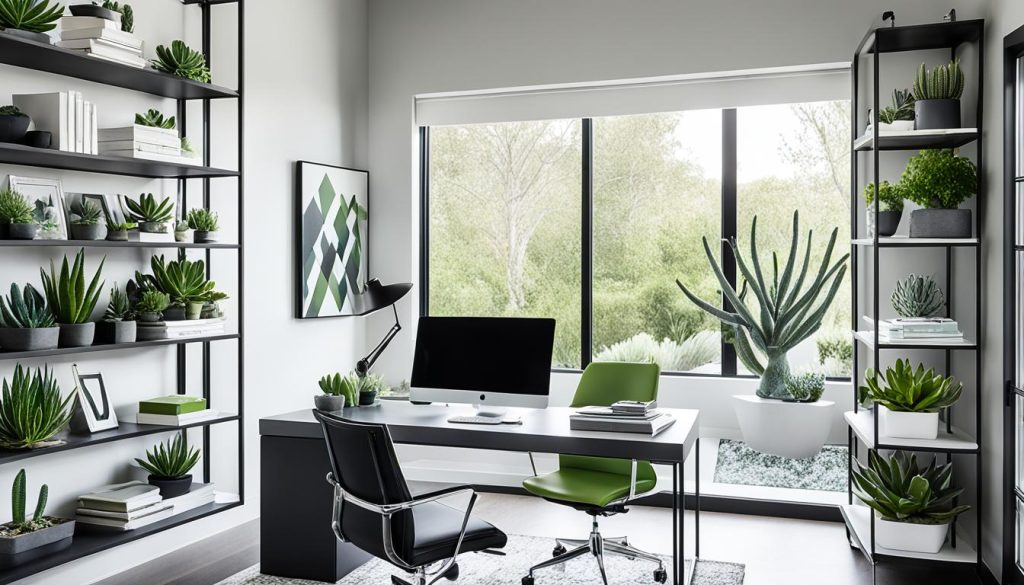
Light colors like pale gray or soft blue can make your office feel bigger and brighter. These colors are calming and help you focus. For a pop of energy, add bold accents. A teal or plum purple wall can inspire creativity without being too distracting.
When choosing decor, pick items that motivate you. Frame your favorite quotes or hang a world map to spark your imagination. Plants are excellent for dual-purpose offices. They clean the air and bring life to your space. Try a mix of desk and floor plants to create a natural, relaxing vibe.
- Use storage that doubles as decor (like pretty boxes or baskets)
- Add a comfy chair or small sofa for when you need a break
- Hang artwork that inspires you and fits your style
Your multifunctional workspace should reflect your personality while staying professional. Soft lighting from table lamps can create a cozy feel for after-work hours. A mix of open shelving and closed storage keeps things tidy and lets you display your favorite items.
“Your workspace should inspire you to create, not just exist.”
By carefully choosing colors and decor, you can create a dual-purpose home office that’s both functional and inviting. It’s all about finding the right balance between work and home life in one space.
Maintaining Work-Life Balance in a Shared Space
It’s key to keep a good balance in a shared living space for your health and work. With over 70% of US employers now offering flexible work setups, it’s vital to set clear work and personal life boundaries at home.
Establishing Boundaries and Routines
Set clear work hours and stick to them. Dress for work to help you switch into professional mode. Use different devices for work and personal stuff to keep your work and personal life separate.
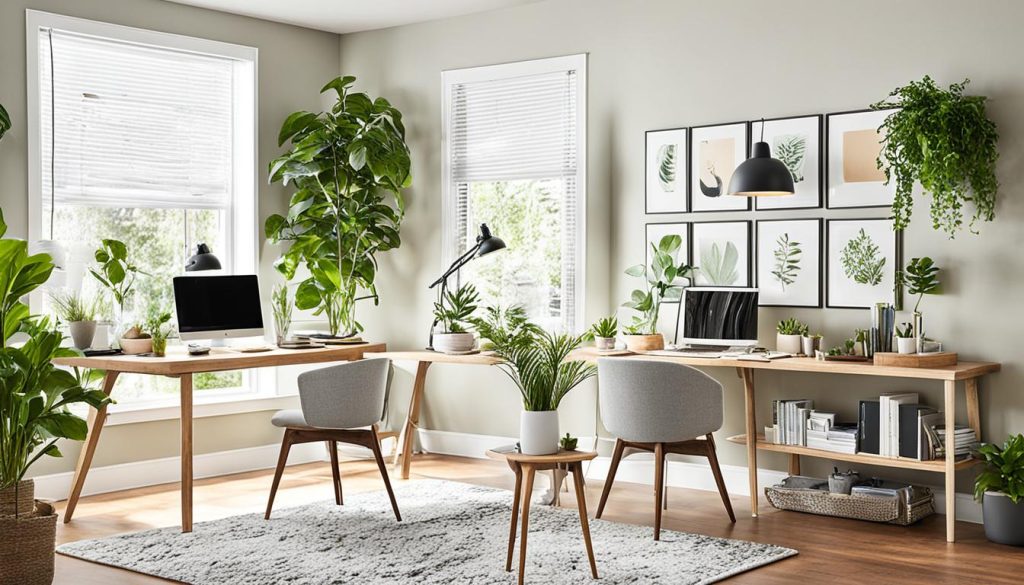
Transitioning Between Work and Personal Time
Do a “mock commute” to mark the start and end of your workday. A short walk or exercise can help you disconnect. Using foldable desks can turn your work area into a relaxing spot.
Creating a Mentally Healthy Environment
Make your living space work well for both work and rest. Add plants, natural light, and soothing colors. Take breaks and don’t eat at your desk. Remember, flexible schedules boost productivity by 29% and focus by 53%.
- Use time blocking to manage tasks efficiently
- Identify and minimize distractions
- Rotate between different work areas in your home
- Stay connected with colleagues through online platforms
With these tips, you can mix work and personal life smoothly in your home office. This approach boosts both your productivity and well-being.
Innovative Room Combinations for Dual-Purpose Offices
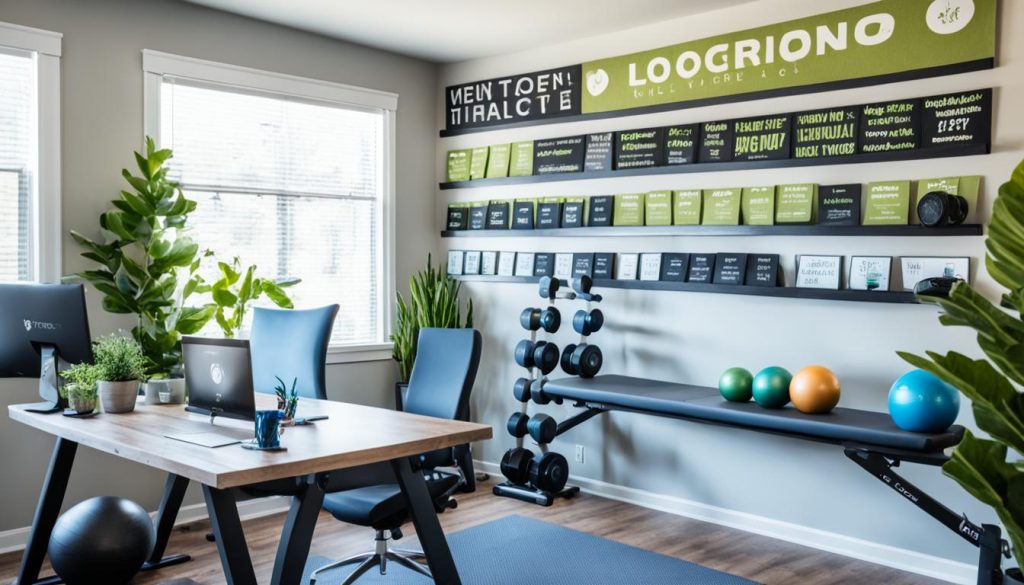
Homeowners are now mixing work and life by creating dual-purpose offices. They use spaces like under the stairs or laundry rooms for desks. These ideas help save space and make work more efficient. Let’s look at some cool ways to update your home office.
Many people turn their dining rooms into offices. This lets you easily switch from work to dinner. A stylish secretary desk can hide your work area when not needed. For smaller spaces, a Murphy bed office is a great idea. It saves floor space by day and turns into a bedroom at night.
Ergonomic workstations are crucial in these shared spaces. Pick desks and chairs that adjust to your needs. Add features like built-in storage and smart lights to make your space better. The aim is to have a room that works well for work and living without losing comfort or efficiency.
- Convert unused nooks into mini-offices
- Use room dividers for visual separation
- Invest in multi-functional furniture
Statistics reveal that 45% of dual-purpose rooms have desks built right in. This design saves space and looks good together. By thinking creatively, you can make any home area into a work spot that fits your life.
Maximizing Productivity in Your Dual-Purpose Space
Make your home office more efficient with smart strategies. Today, 90% of workers feel more productive in spaces designed for ergonomics. Begin by creating a work area, even if it’s a small spot in your apartment.
Choose the right tools for your job. 73% of remote workers find less neck strain with adjustable monitor stands. Think about using floating desks or vertical storage to keep your space tidy and focused.
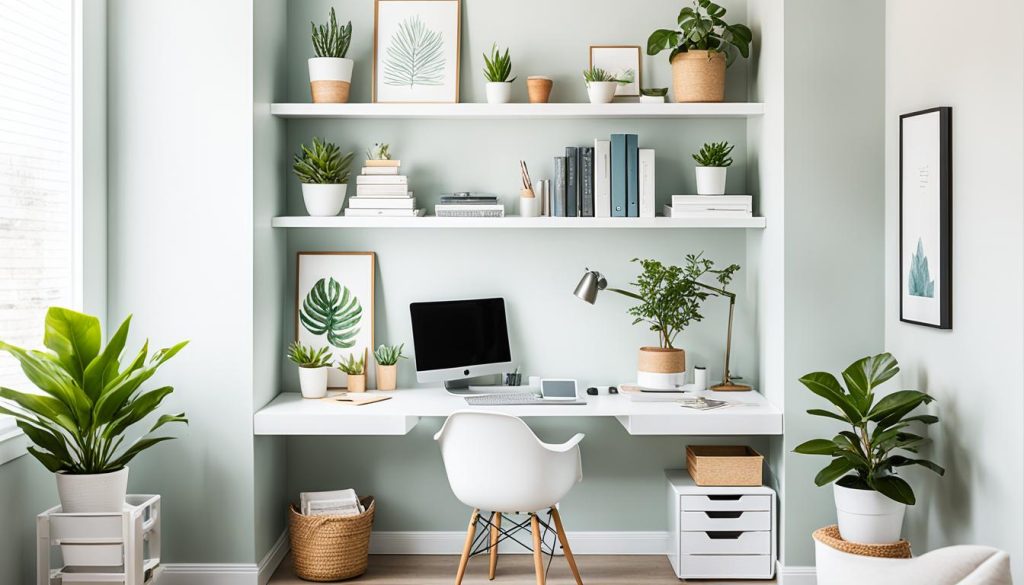
Lighting is key to staying productive. 85% of workers feel more alert with the right lighting. Try to place your desk near a window if you can. Natural light can increase energy by 60% during work hours.
Smart layouts can change how you work from home. Here are some tips to boost your productivity:
- Use noise-canceling headphones to reduce distractions
- Implement a cable management system for a tidy workspace
- Add plants to your office space – 82% of workers note improved cognitive function with indoor greenery
- Choose a color scheme that promotes focus and creativity
A well-organized dual-purpose space can improve your work-life balance. By using these strategies, you’ll make an environment that helps both your work and personal life.
Final Thoughts
Creating a dual-purpose home office is a smart move for today’s work needs. It lets you use your space wisely and keep a good balance between work and life. The goal is to make a space that easily changes from work to home use.
Your home office should match your needs and style. You might use a guest room or basement. Use furniture that does more than one thing, smart storage, and good lighting. These things help make a space that works well for different tasks.
Starting your flexible office layout project means trying new things and making changes. Many people find their dual-purpose areas change over time. By always improving your setup, you’ll get a space that helps you in work and life. This way, you use your home to its fullest.



